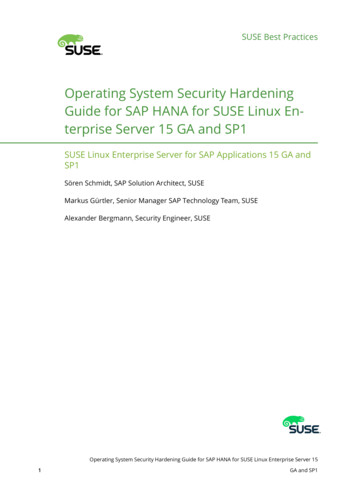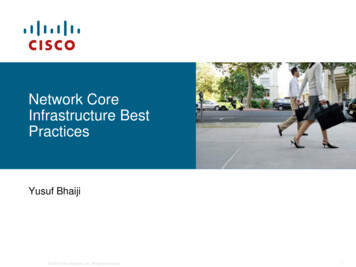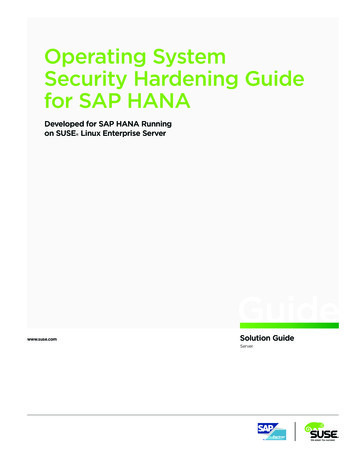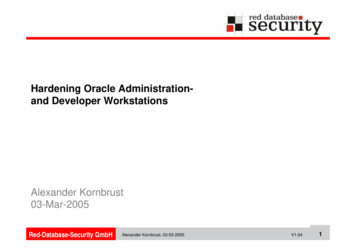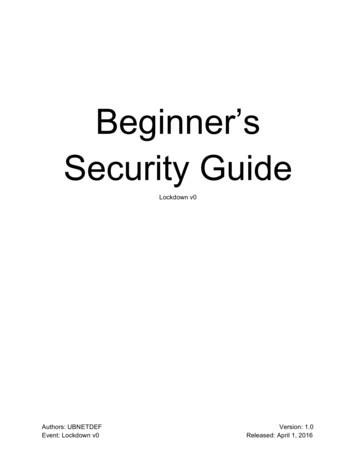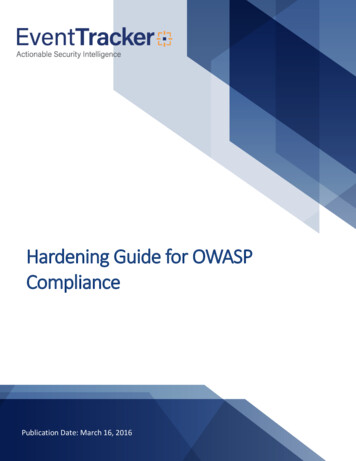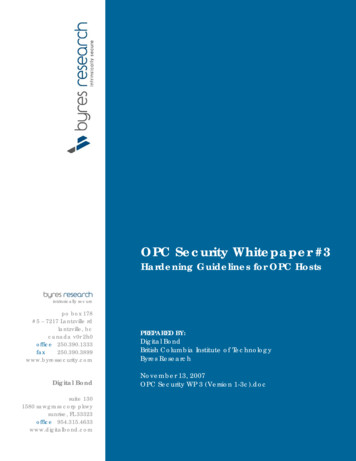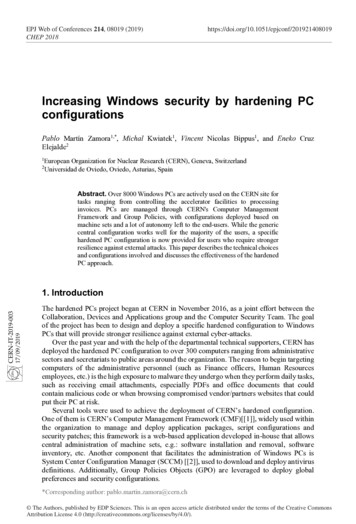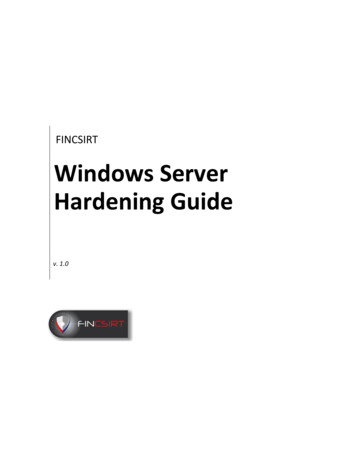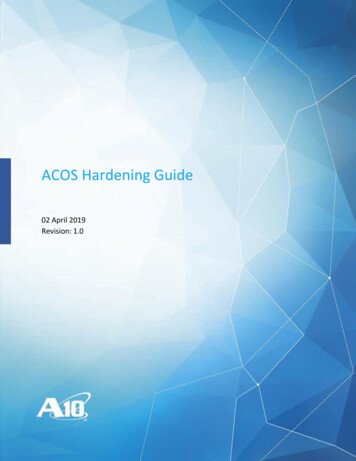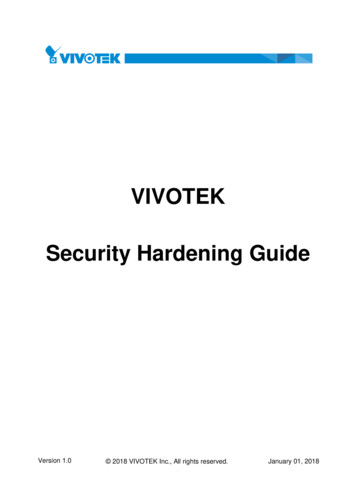
Transcription
VIVOTEKSecurity Hardening GuideVersion 1.0 2018 VIVOTEK Inc., All rights reserved.1January 01, 2018
About this DocumentSupportThe intended use of this guide is to harden devices andalso provide collateral for deployment teams to deal withlocal network policy, configurations and specification.All settings described in this document are made in theproduct’s webpages. To access the webpages, see theUser Manual of the specific product.Liability/ DisclaimerShould you require any technical assistance, pleasecontact your VIVOTEK reseller/distributor. VIVOTEKdistributor contact information could be found onWhere to Buy section at VIVOTEK website. Toenhance customer satisfaction, your reseller/distributor will reach us in a timely manner if the issueis not solved with first response.Please inform your local VIVOTEK office of anyinaccuracies or omissions. VIVOTEK cannot be heldresponsible for any technical or typographical errors andreserves the right to make changes to the product andmanuals without prior notice. VIVOTEK makes nowarranty of any kind with regard to the material containedwithin this document, including, but not limited to, theimplied warranties of merchantability and fitness for aparticular purpose. VIVOTEK shall not be liable norresponsible for incidental or consequential damages inconnection with the furnishing, performance or use of thismaterial. This product is only to be used for its intendedpurpose.We encourage you to take advantage of the manyonline resources VIVOTEK offers. VIVOTEK Downloads: With useful materials,such as brochure, firmware/software update. VIVOTEK Support: Including Top FAQ,Technical Videos, and Security HardeningGuide with efficient on-line assistance. VIVOTEK Customer Community: To obtainassistance from VIVOTEK technical supportteam, you can register and discuss problems inour on-line customer community and engagemore with VIVOTEK’s solutions, and service.Intellectual Property RightsLearning CenterVIVOTEK has intellectual property rights relating totechnology embodied in the product described in thisdocument. In particular, and without limitation, theseintellectual property rights may include one or more of thepatents or pending patent applications in the Taiwan,United Sates and other countries. This product containslicensed third-party software also. Please visit VIVOTEKwebsite for more information.Visit VIVOTEK Learning Center for advanced featurearticles and white papers and enjoy VIVOTEK WarriorAcademy global training program.Contact InformationVIVOTEK INC.6F, No. 192, Lien-Cheng Rd., Chung-Ho Dist., NewTaipei City, Taiwan. R.O.C. 23353Tel: 886-2-8245-5282Fax: 886-2-8245-5532https://www.vivotek.com/Trademark AcknowledgmentsThe trademark "VIVOTEK" or any other trademarks,service marks, trade names, distinctive logos, pictures, ordesigns as designated by VIVOTEK and as used on or inconnection with the Product are the sole properties ofVIVOTEK ("VIVOTEK Trademarks and Trade Names").VIVOTEK are registered trademarks or trademarkapplications in various jurisdictions. All other companynames and products are trademarks or registeredtrademarks of their respective companies.User hereby acknowledges and recognizes that any andall "VIVOTEK’s Trademarks and Trade Names, patents,copyrights, know-how and other intellectual propertyrights” used or embodied in the Product are and shallremain the sole properties of VIVOTEK.2
Table of ContentsIntroduction4BasicUpgrade FirmwareSet Root PasswordDisable Anonymous viewingPrivilege managementSetup System TimeCorrection TimeNTP ServerEnable HTTP Digest AuthenticationEnable RTSP Streaming AuthenticationDisable Unused ServicesDisable AudioDisable UPnPDisable IPv6Disable Always MulticastDisable SNMP556789991011121212131313AdvancedAdd user for VMS and other viewersEnable HTTPS to Encrypt TrafficReinforce Access ListMaximum number of concurrent streamingEnable Access List FilteringEnable Remote LogsChange the default port1515151717171818EnterpriseDeploy IEEE 802.1x Authentication SolutionIPAM / VLAN / SubnetEnable Log and Access Control on Switches19191920OthersPhysical sabotageSubscribe VIVOTEK newsletter212121Appendix A - The CIS Critical Security Controls for Effective Cyber Defense Version6.1223
IntroductionThere is an information security team to review the product design inside VIVOTEK andVIVOTEK also has cooperated with many well-known information security companies formany years to make sure our products are secure.However proper camera and network configurations are also key to security surveillancesystems.There are many suggestions for cyber defense in the document "The CIS Critical SecurityControls for Effective Cyber Defense" (https://www.cisecurity.org/critical-controls/), we willinstruct you all the related settings in the following chapter according to those suggestions.Security related settings are divided into 3 levels : Basic, Advanced and Enterprise. You maydetermine the security level according to your environment and requirements.Basic: We recommend you at least achieve the basic level. It is usually for closed networkenvironments.Advanced : Including the settings of Basic level and provides the settings for WAN accessible/ Under insecurity network or risk environments.Enterprise : Including the settings of Basic and Advanced levels and provides the settings forcorporation with complex and sound network infrastructure and IT management.4
BasicUpgrade FirmwareCSC 2: Inventory of Authorized and Unauthorized SoftwareCSC 4: Continuous Vulnerability Assessment and RemediationCSC 18: Application Software SecurityAlways use the latest firmware. The latest firmware will fix all security issues and patch thesecurity update from 3rd party libraries.Not only public vulnerabilities, the latest firmware will also fix all the internal security issuesuncovered by the VIVOTEK security team.5
Set Root PasswordCSC 5: Controlled Use of Administrative PrivilegesThe default password is blank and leaving the root password field empty means the camerawill disable user authentication whether there are other existing accounts or not. Pleaseassign a password as soon as possible once you enable the camera because it is VERYDANGEROUS and not recommended to leave it blank.Assigning a password is very critical, and a good password just as important. A weakpassword is also dangerous, such as simple numbers:123456, 111111, and so are commonwords, such as admin, root, pass, qwerty. and so on.Passwords should contain: a minimum of 1 lower case letter [a-z] and a minimum of 1 upper case letter [A-Z] and a minimum of 1 numeric character [0-9] and a minimum of 1 special character: ! %-.@ and the length must be at least 8 characters long.6
Disable Anonymous viewingCSC 16: Account Monitoring and ControlUncheck [Allow Anonymous viewing] if the camera is not public.Once you enable Allow Anonymous viewing, the RTSP streaming authentication will beignored.7
Privilege managementCSC 5: Controlled Use of Administrative PrivilegesCSC 16: Account Monitoring and ControlThere are 3 user groups inside VIVOTEK cameras: Administrator, Operator and Viewer.For users that only need viewing privilege, just assign a Viewer account for them.8
Setup System TimeCSC 6: Maintenance, Monitoring, and Analysis of Audit LogsTime CorrectionCorrect dates and times are very important for incident response and data forensics.Therefore it is critical that in the system/application logs time-stamps have correctinformation.NTP ServerIt is recommended to synchronize the date/time with an NTP server. For public NTP server,please be careful of vulnerable servers.9
Enable HTTP Digest AuthenticationCSC 13: Data ProtectionCSC 14: Controlled Access Based on the Need to KnowCSC 16: Account Monitoring and ControlWith Basic Authentication the user credentials are sent as cleartext and while HTTPS is not used,they are vulnerable to packet sniffing.Use digest authentication if possible or enable HTTPSVIVOTEK cameras support SSL and TLS, but we highly recommend using TLS 1.2 for bettersecurity. You may disable SSL and old TLS (1.0, 1.1) from your browser settings panel.10
Enable RTSP Streaming AuthenticationCSC 13: Data ProtectionCSC 16: Account Monitoring and ControlRTSP streaming authentication is a bit different from HTTP, it has a "disable" option in theauthentication type. Unless your VMS/NVR doesn't support RTSP authentication, wesuggest to use basic or digest strongly.11
Disable Unused ServicesCSC 9: Limitation and Control of Network Ports, Protocols, and ServicesCSC 13: Data ProtectionDisable AudioIf you don't need audio, check the [Mute] checkbox to protect the acoustic privacy.Disable UPnPIf you don't use UPnP function, disable the UPnP presentation and UPnP port forwarding12
Disable IPv6Disable IPv6 if you do not need it.Disable Always MulticastUncheck always multicast, if you do not use it, to avoid flooding your audio/video datanetwork. The camera can still mulitcast based on client’s request.Disable SNMPDisable SNMP if you do not need this function.SNMPv1 and SNMPv2 are not secure, if you really need SNMP, please adopt SNMPv313
14
AdvancedAdd user for VMS and other viewersCSC 5: Controlled Use of Administrative PrivilegesThe root account has a higher privilege than the administrator (network services, such asFTP), please do not use the root account for VMS/NVR, as it can reduce the risk once theVMS/NVR is compromised by an attacker.Enable HTTPS To Encrypt TrafficCSC 3: Secure Configurations for Hardware and Software on Mobile Devices,CSC 13: Data ProtectionHTTPS will encrypt all the traffic between client and device.There are two types for the certificate1. Self-signed certificatea. Self-signed is adequate for encryption purposes, but it has risk of MITMattack2. CA-signed certificatea. You have to create certificate request, and send it to CA for signing. With CAsigned certificate, you can identify the camera confidently.15
Video and audio streaming through RTSP/RTP won’t be encrypted, and it is under the risk ofsniffing. If you want to encrypt all Video/Audio data:1. If you connect the camera using the cameras web interface, please choose HTTP inthe protocol options of Client setting, and use https://IP-CAMERA to connect.2. If you connect the camera by VMS/NVR, please make sure the protocol is RTSPover HTTPS16
Reinforce Access ListCSC 12: Boundary DefenseCSC 14: Controlled Access Based on the Need to KnowMaximum number of concurrent streamingYou may limit the maximum number of concurrent streaming if you know exactly how manyclients will connect to this device.Enable Access List FilteringEnable access list filteringIf this device is only accessible by some certain clients (VMS/NVR/browser), you may set theallow list to strengthen security.17
Enable Remote LogsCSC 4: Continuous Vulnerability Assessment and RemediationCSC 6: Maintenance, Monitoring, and Analysis of Audit LogsRemote log is an important function for enterprise-level surveillance systems. The local logcould be erased once the device is compromised, but with remote log, the difficulty isincreased.Change the default portCSC 11: Secure Configurations for Network Devices such as Firewalls, Routers,Changing the default HTTP/RTSP doesn't provide any serious defense against atargeted attack, but it will prevent some non-targeted and amateur script type attacks.18
EnterpriseDeploy IEEE 802.1x Authentication SolutionCSC 1: Inventory of Authorized and Unauthorized DevicesCSC 11: Secure Configurations for Network Devices such as Firewalls, Routers,and SwitchesCSC 15: Wireless Access ControlIEEE 802.1X is an IEEE Standard for port-based Network Access Control (PNAC), itprovides an authentication mechanism to devices wishing to attach to a LAN or WLAN. Youcan prevent unauthenticated devices from attaching to your network environment, andreduce the possibility of forging camera video.EAP-TLS provides stronger security by requiring both server and client side certificate.Choose the one suited for your network infrastructure or contact the network administrator.IPAM / VLAN / SubnetCSC 11: Secure Configurations for Network Devices such as Firewalls, Routers,and SwitchesCSC 12: Boundary DefenseCSC 14: Controlled Access Based on the Need to Know19
IP management is a basic work to reduce cyber threat. You should know the owner of eachIP address and limit the available unused IP addresses.You can use IPAM and proper subnet plan to archive it.IPAM https://en.wikipedia.org/wiki/IP address managementVLAN is also a good tool for IP management. It allows you to isolate your surveillancesystem from the regular network environment.Enable Log and Access Control on SwitchesCSC 6: Maintenance, Monitoring, and Analysis of Audit LogsCSC 11: Secure Configurations for Network Devices such as Firewalls, Routers,and SwitchesYou can enhance the security levels via other network devices, such as switches, the switchcan enhance the "access list" and "log" functions:1. Limit access on switchesa. Only a specific MAC address can access through a specific port2. Enable Loga. You may enable the log on the switch to keep more information of networktrace, and it may help on incident response.20
OthersPhysical damageCSC 1: Inventory of Authorized and Unauthorized DevicesThe most apparent threat to a network camera is physical damage, you may choose theproper camera model to reduce the risk of physical damage.Subscribe to the VIVOTEK newsletterCSC 4: Continuous Vulnerability Assessment and RemediationVIVOTEK will publish security news on our website and newsletter when any security issueoccurs.21
Appendix A - The CIS Critical Security Controlsfor Effective Cyber Defense Version C 1: Inventory of Authorized and Unauthorized DevicesActively manage (inventory, track, and correct) all hardware devices on thenetwork so that only authorized devices are given access, and unauthorized andunmanaged devices are found and prevented from gaining access.CSC 2: Inventory of Authorized and Unauthorized SoftwareActively manage (inventory, track, and correct) all software on the network so thatonly authorized software is installed and can execute, and that unauthorized andunmanaged software is found and prevented from installation or execution.CSC 3: Secure Configurations for Hardware and Software on Mobile Devices,Laptops, Workstations, and ServersCSC 4: Continuous Vulnerability Assessment and RemediationContinuously acquire, assess, and take action on new information in order toidentify vulnerabilities, remediate, and minimize the window of opportunity forattackers.CSC 5: Controlled Use of Administrative PrivilegesThe processes and tools used to track/control/prevent/correct the use, assignment,and configuration of administrative privileges on computers, networks, andapplications.CSC 6: Maintenance, Monitoring, and Analysis of Audit LogsCollect, manage, and analyze audit logs of events that could help detect,understand, or recover from an attack.CSC 7: Email and Web Browser ProtectionsMinimize the attack surface and the opportunities for attackers to manipulatehuman behavior though their interaction with web browsers and email systems.CSC 8: Malware DefensesControl the installation, spread, and execution of malicious code at multiple pointsin the enterprise, while optimizing the use of automation to enable rapid updatingof defense, data gathering, and corrective action.CSC 9: Limitation and Control of Network Ports, Protocols, and ServicesManage (track/control/correct) the ongoing operational use of ports, protocols,and services on networked devices in order to minimize windows of vulnerabilityavailable to attackers.CSC 10: Data Recovery Capability22
The processes and tools used to properly back up critical information with a provenmethodology for timely recovery of it.CSC 11: Secure Configurations for Network Devices such as Firewalls, Routers, andSwitchesEstablish, implement, and actively manage (track, report on, correct) the securityconfiguration of network infrastructure devices using a rigorous configurationmanagement and change control process in order to prevent attackers fromexploiting vulnerable services and settings.CSC 12: Boundary DefenseDetect/prevent/correct the flow of information transferring networks of differenttrust levels with a focus on security-damaging data.CSC 13: Data ProtectionThe processes and tools used to prevent data exfiltration, mitigate the effects ofexfiltrated data, and ensure the privacy and integrity of sensitive information.CSC 14: Controlled Access Based on the Need to KnowThe processes and tools used to track/control/prevent/correct secure access tocritical assets (e.g., information, resources, systems) according to the formaldetermination of which persons, computers, and applications have a need and rightto access these critical assets based on an approved classificationCSC 15: Wireless Access ControlThe processes and tools used to track/control/prevent/correct the security use ofwireless local area networks (LANS), access points, and wireless client systems.CSC 16: Account Monitoring and ControlActively manage the life cycle of system and application accounts – their creation,use, dormancy, deletion – in order to minimize opportunities for attackers toleverage them.CSC 17: Security Skills Assessment and Appropriate Training to Fill GapsFor all functional roles in the organization (prioritizing those mission-critical to thebusiness and its security), identify the specific knowledge, skills, and abilitiesneeded to support defense of the enterprise; develop and execute an integratedplan to assess, identify gaps, and remediate through policy, organizationalplanning, training, and awareness programs.CSC 18: Application Software SecurityManage the security life cycle of all in-house developed and acquired software inorder to prevent, detect, and correct security weaknesses.CSC 19: Incident Response and ManagementProtect the organization’s information, as well as its reputation, by developing andimplementing an incident response infrastructure (e.g., plans, defined roles,training, communications, management oversight) for quickly discovering an attack23
and then effectively containing the damage, eradicating the attacker’s presence,and restoring the integrity of the network and systems.CSC 20: Penetration Tests and Red Team ExercisesTest the overall strength of an organization’s defenses (the technology, theprocesses, and the people) by simulating the objectives and actions of an attacker.24
Enterprise Deploy IEEE 802.1x Authentication Solution CSC 1: Inventory of Authorized and Unauthorized Devices CSC 11: Secure Configurations for Network Devices such as Firewalls, Routers, and Switches CSC 15: Wireless Access Control IEEE 802.1X is an IEEE Standard for port-based Network Access Control (PNAC), it
